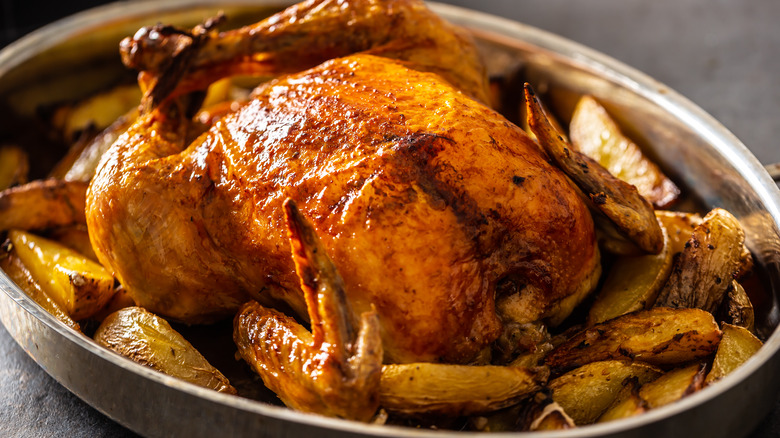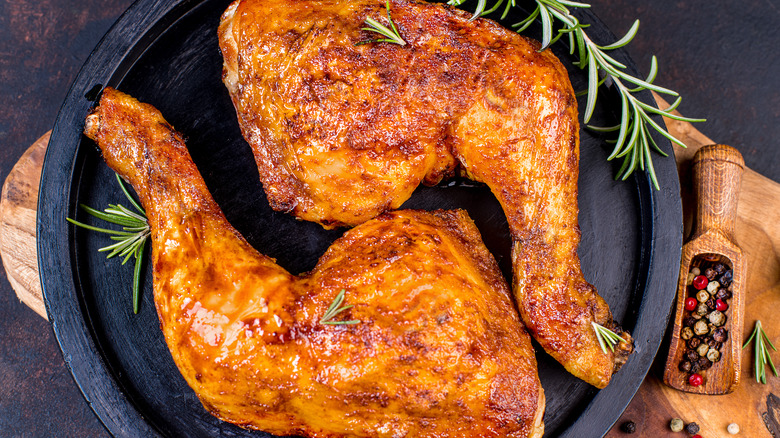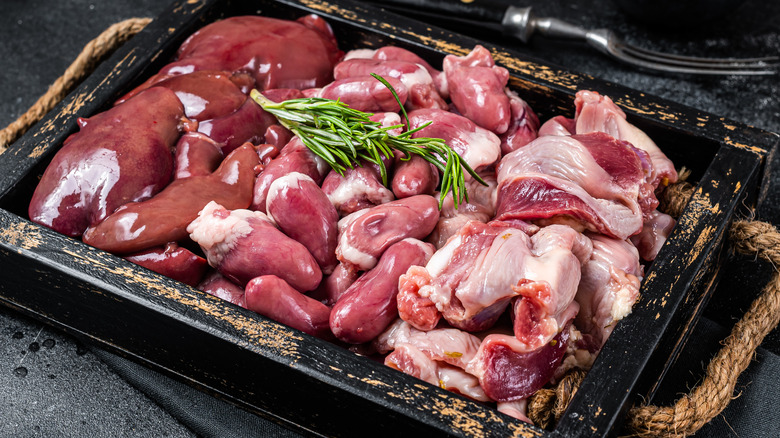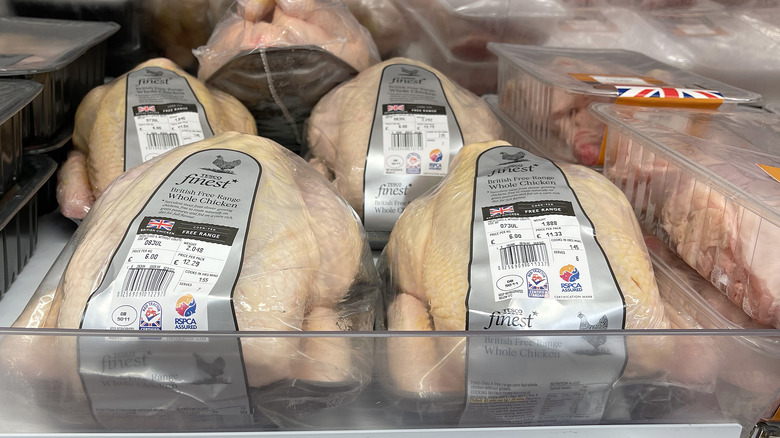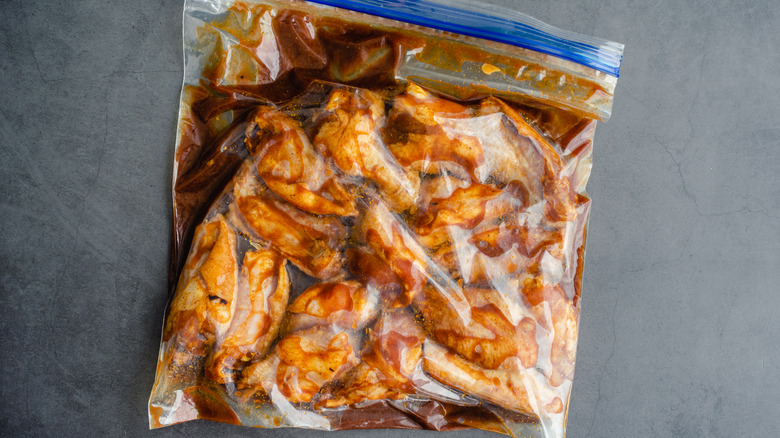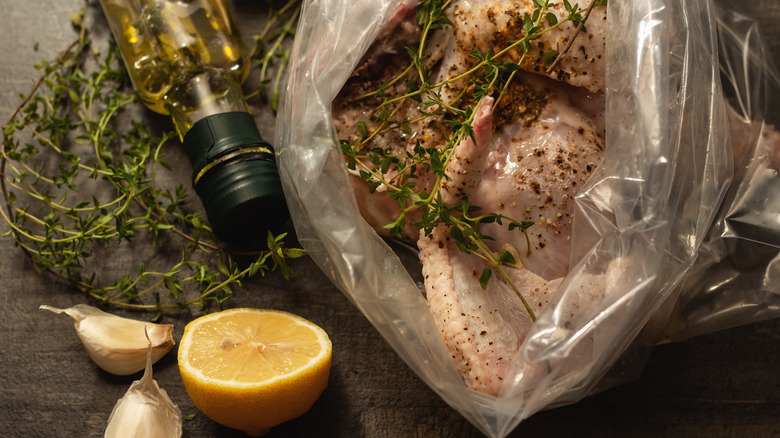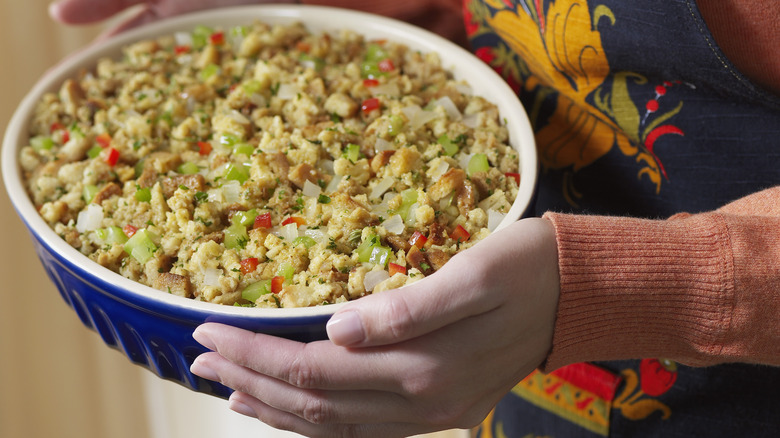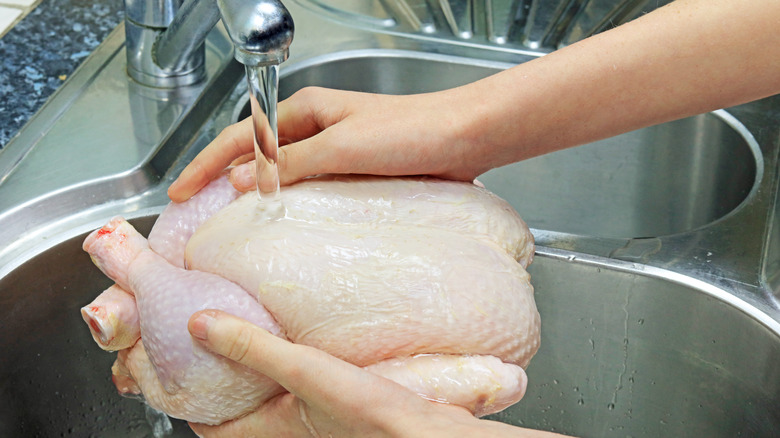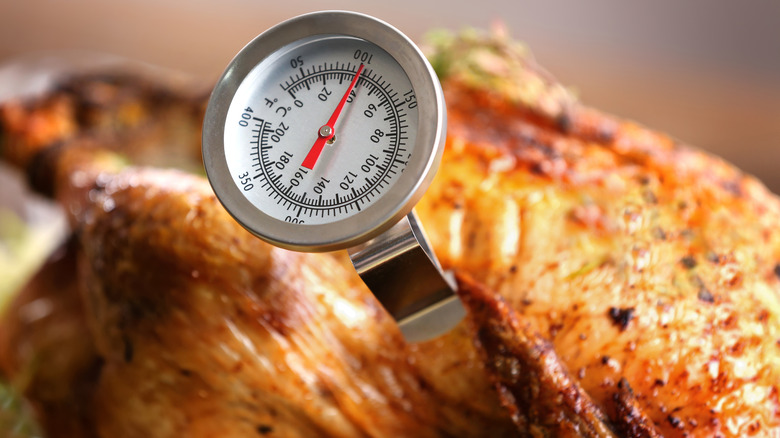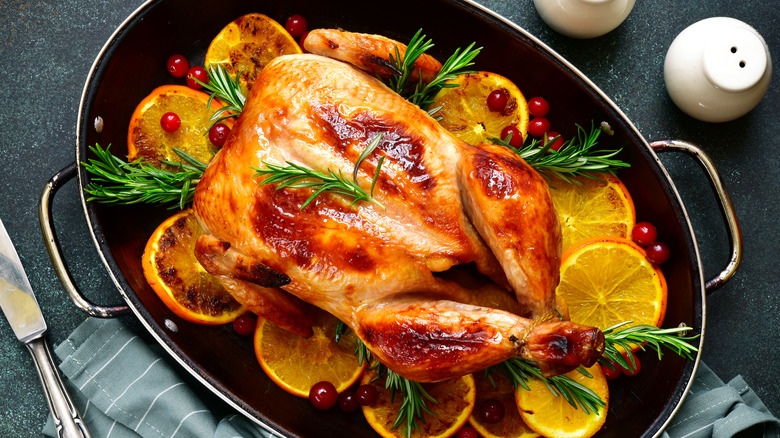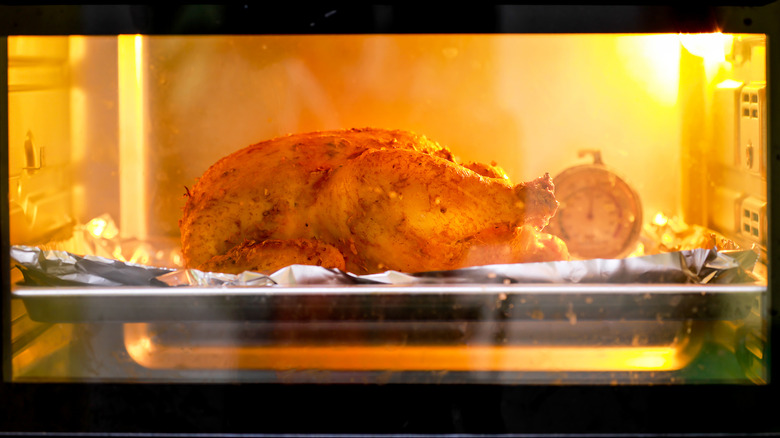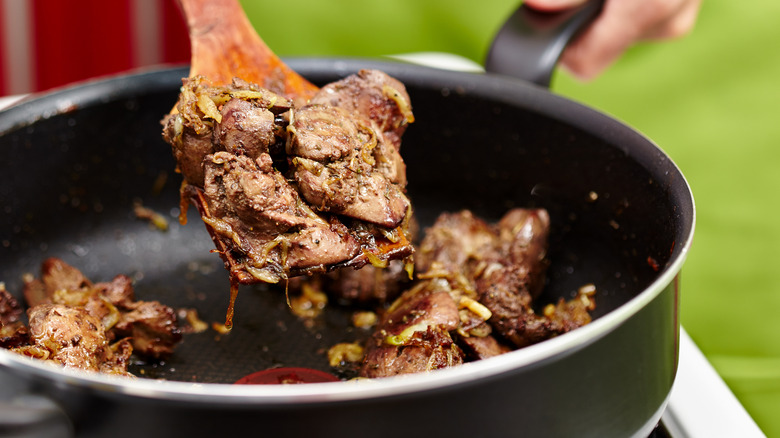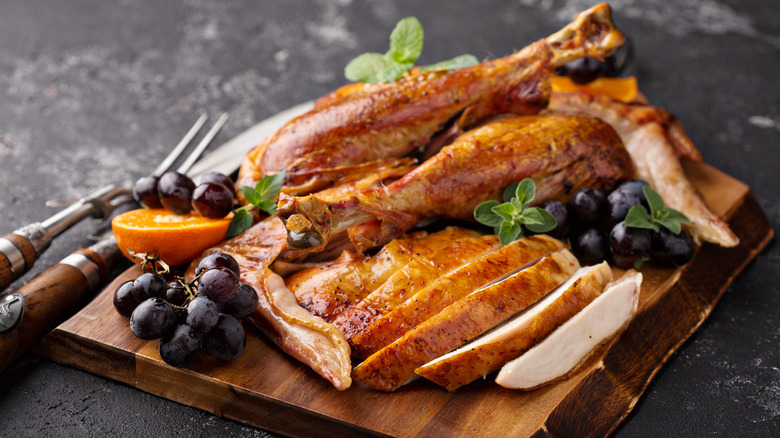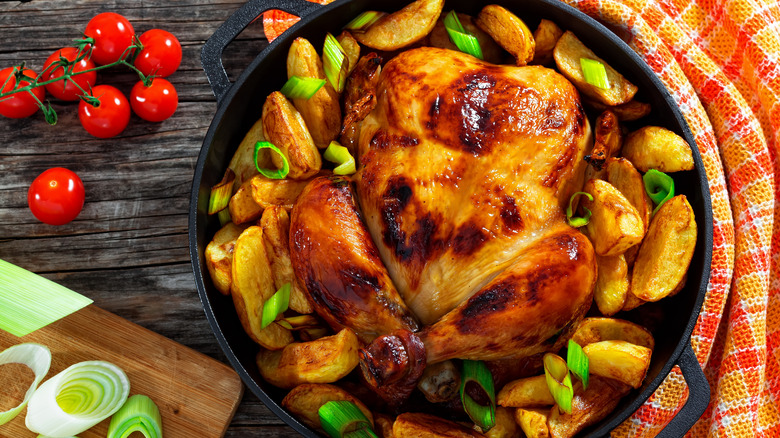13 Things You Need To Do When Cooking A Whole Chicken
Cooking a whole chicken might seem intimidating at first. After all, for a lot of home chefs, roasting a whole bird carries strong reminders of Thanksgiving dinner. And, let's be honest, not everyone always feels up to cooking a whole turkey. However, as this piece in Bon Appétit notes, roasting a chicken is infinitely easier than roasting a turkey. This is because chickens are several pounds lighter than their larger cousins, which means that they require significantly less cooking time. On top of that, smaller birds are easier to pull out of the oven so you can prepare them without any heavy lifting.
Beyond the convenience factor, roasted chickens are super healthy. According to Healthline, eating different parts of a full bird — skin and all — can give you access to lots of important vitamins and minerals. One portion of roast chicken breast (including the skin) contains 50% of your daily dose of niacin, an important antioxidant. Meanwhile, the chicken's thigh is rich in selenium, a mineral that can ward off health issues like cancer and thyroid problems (via Harvard School of Public Health).
Because of all these factors, it can be a great idea to try your hand at roast chicken. This recipe from TastingTable takes less than two hours to cook and offers a delicious combination of flavors, like lemon, sea salt, and thyme. Before you start cooking, however, there are a couple of things you need to do first.
1. Map out your portion sizes
Before you do anything involving an actual chicken, take a minute and reflect on the meal ahead. How many people are coming to your dinner? Do the guests prefer light meat or dark meat? Are you hoping to have leftovers? These questions will help you determine what size of whole chicken you should look for. A good rule of thumb is that you should allow around a pound of whole chicken per guest, according to TastingTable. This means that one four-pound chicken should be plenty of food for four, while two five-pound chickens should be adequate for a party of ten.
Of course, if you are looking forward to leftovers, you can prepare more food than necessary for the number of dinner guests. Keep in mind, however, that dark meat tends to be better for certain leftovers than white meat, as per Mashed. The reason for this is that dark meat adds more natural juiciness and flavor to meals like chicken soup, due to its high content of red fibers. So, if you are hoping to use your leftover meat to make this chicken noodle soup recipe, set some wings and thighs off to the side. You may end up using them the following day.
2. Decide whether or not you want a chicken with giblets
Once you have decided what size chicken to look for, you should think about whether or not you want a chicken that comes with giblets. Giblets are a mixture of the chicken's organs, which generally include the gizzards, liver, and heart. Back in the day, almost all whole chickens were sold with giblets, and some of them even came with the bird's head, neck, and feet. In 2022, however, not all consumers are interested in these delightful ingredients. According to The New Statesman, some brands have stopped selling gizzards and other organs along with whole chickens. Because of this, you should decide whether or not you want to cook with giblets before you even buy the bird.
While giblets have recently decreased in popularity in the United States, they continue to be an essential part of many popular recipes. Traditional homemade gravy, for example, is often made with the giblets, as these organs add a meaty flavor to the sauce. To make the perfect gravy, start out by pan-searing the giblets, then add water, veggies, and seasonings to create a flavorful stock. Thicken with roux and you have gravy. When you finally serve your roast chicken, you top it with a healthy portion of this traditional sauce.
3. Pick the freshest chicken
Although it can be fun to try out elaborate cooking tricks, many professional chefs recommend sticking to the basics. Among them is cooking sensation Chef Kelvin Cheung, who attributes his own success to his ability to keep things simple. In an interview for YS Weekender, Cheung shared his top three tips for making a delicious meal: "Always use the best fresh, local ingredients, cook with simplicity, and always strive for balance in your dish." With this advice in mind, remember that making a good whole chicken starts with choosing high-quality ingredients. In that sense, one of the best things you can do to start your recipe off right is to buy a fresh bird.
To choose the best whole chicken, take a good look at the color of the meat. If the meat seems bruised, or gray, this could be a sign of decreased chicken quality (via Aeon Says). You should also keep an eye out for water or other fluids building up inside the package. According to Smart Chicken, an overflow of liquid could be a sign that your bird has spent too much time in its packaging. Ideally, select a chicken that has a healthy, pinkish color and meat that is firm to the touch. These are both key signs that the meat is fresh enough to enjoy.
4. Choose a marinade
It's no secret that roasting a whole chicken is a great way to bring out the bird's natural flavors. As New York Times food editor Sam Sifton told Salon, "[A] roast chicken dinner is a complete explanation of why we cook ... It is this fragrant, crackly, sweet, salty, easily devourable ... meal." That being said, many people enjoy savoring the chicken's natural juices in combination with other ingredients. One common way to do this is by marinating your whole chicken in a mixture of elements that could include oil, herbs, spices, and even wine. However, before beginning this step, you must choose a marinade for your bird.
To decide on a marinade, think about what kinds of flavors you'd like to incorporate into your dinner. If you are preparing a Japanese-style meal, for example, you might consider using a teriyaki marinade made from a combination of teriyaki sauce, garlic, onion, and ginger. Alternatively, you can add a spicier taste to your whole chicken by marinating it in a jalapeño and mustard marinade.
If you aren't sure what kind of marinade to choose — or you have never made a marinade before — don't worry. There are plenty of basic marinades that combine well with any kind of dinner. One easy option is to simply soak your bird in olive oil, rosemary, thyme, and lemon juice.
5. Let your bird soak
After you have mixed the ingredients to make your marinade, it's time to soak your bird. The best way to do this is to first fill a large plastic bag with the marinade and then seal the whole chicken inside. Since poultry is famous for spoiling easily, be sure not to marinate the chicken on the kitchen counter (via CDC). Instead, let the whole chicken marinate inside the fridge until you are ready to roast it.
When it comes to deciding how long to marinate your chicken, your choice will depend on how much flavor you want the meat to absorb. The longer you marinate the bird, the stronger the taste will be. According to Yahoo! Life, you can soak the whole chicken for anywhere between four and 12 hours for the best results. However, if you are in a rush, there is no problem with marinating the meat for less time. As Chef Kevol Graham and Chef Omar Loney told the outlet, "If it's dinner time and you need to whip up a quick but delicious recipe, marinating your chicken for a minimum of 30 minutes will suffice."
6. Decide on a stuffing
The word "stuffing" probably brings to mind images of a Thanksgiving turkey overflowing with traditional holiday goodies. However, most chefs no longer recommend cooking that traditional mixture of, say, bread and cranberries inside the whole chicken. The reason is that doing so can actually decrease the quality of the meat. As Chef Neil Rankin told Mr Porter, "Don't cook the stuffing in the bird as it blocks the airflow, generally gets overcooked, slows down the cooking time, and increases the chances of drying out the breast."
While traditional stuffing might be a no-go, what you do need is to fill the chicken's inner cavity with aromatics. Aromatics are flavorful foods that can enrich the taste of the bird. These foods can incorporate a number of ingredients ranging from roast vegetables to citrus to spices. And, according to Julia Child, forgetting to add aromatics to your chicken is a huge mistake. As Child revealed in a PBS video, simply adding lemons and rosemary to the cavity of your bird can enhance the flavor of the meat.
Of course, deciding which aromatics or stuffing to choose will depend largely on your marinade. Julia Child's recommended lemons and rosemary might work well with a French marinade, while they could clash with a teriyaki one. Exploring these flavor combinations can help you decide which aromatics to use.
7. Do not wash your chicken
As you start preparing your whole chicken, you may feel the impulse to wash it. After all, for many years, this was an important step in cooking poultry. However, according to the Consumer Reports director of food safety, James E. Rogers, Ph.D., rinsing your chicken is not a great idea. As Rogers told Consumer Reports, "People think they have to wash or rinse chicken before they cook it for many reasons — because their mama did it, they think they need to remove slime or blood, or they think it's safer. But doing this may actually increase your chances of getting food poisoning."
The reason for this is that raw poultry is covered with harmful bacteria, like salmonella and clostridium perfringens, according to the CDC. And, unfortunately, whenever you handle a raw chicken, some of the bacteria from the bird is transferred to anything it came into contact with. In practice, this means that when you rinse your chicken in the sink, this bacteria can splatter all over your sink, counter, and faucet. This increases the risk of cross-contamination and, therefore, food poisoning.
Instead of cleaning your chicken in the sink, pat the bird with paper towels, as suggested by EatingWell. After absorbing some of the bird's juices, place the contaminated paper towels directly in the trash without placing them anywhere on the counter. You should also be sure to wash your hands every single time that you handle raw chicken meat.
8. Find a meat thermometer
Keeping your chicken out of the sink is not the only way to avoid the spread of food-borne illnesses. Using a meat thermometer will also help you ensure that your chicken is free of dangerous bacteria. According to the USDA, no type of poultry is not safe to eat until the bird's internal temperature raises to 165 degrees Fahrenheit. This means that even chicken meat that looks "done" could still contain traces of salmonella and clostridium perfringens if it hasn't reached the proper internal temperature.
To ensure that your chicken is safe to consume, purchase a high-quality meat thermometer. Before using the device, be sure to test it out. You can do so by setting your fridge to a specific temperature and then placing the meat thermometer inside for about twenty minutes. If the temperature of your fridge is correctly reported on your meat thermometer, you can be certain that the device is actually functional.
When it comes time to cook your bird, place the sharp part of the meat thermometer inside your chicken. As per MasterClass, you should be sure to put the thermometer in the thickest part of the meat. For a whole chicken, this should be the meat in the inner thigh that is almost touching the breast. When you insert the thermometer, do not let the metal touch the chicken's bone, as this could give you incorrect results (via Almanac).
9. Prepare your chicken for roasting
At this point, your whole chicken should be almost ready to stick in the oven. The meat should be marinated, the stuffing should be arranged, and you should have a meat thermometer ready for action. Now, you just need to prepare the chicken for cooking. For this step, you will need a deep pan that is a little bit longer and wider than your bird. First, you should throw some butter or oil on the bottom of the pan so that the chicken won't stick. Next, set the chicken inside the pan with its breast facing down. This ensures that the fat from the dark meat will trickle down to the bottom of the pan, creating a succulent juice that will add flavor to the chicken breast (via Huffington Post). This juice will also prevent the chicken's white meat from coming out dry, improving the overall texture of your dinner.
After placing the chicken in the pan, wash your hands well. It's time to cut up some fruits or vegetables. As per Bon Appétit, cooking your whole chicken in a bed of veggies can significantly improve your roast. For one thing, it makes the whole chicken look more appetizing when it comes out of the oven. And, for another, it means that your chicken will come out with a side of delicious roasted veggies.
10. Cook your chicken
Finally, after all this preparation, you will be able to put your whole chicken into the oven. Keep in mind that the larger the bird, the longer you need to cook it. Other factors that can determine how long you need to roast the chicken can include the quality of your oven, the shape of your chicken, and how thick the meat is. The only safe way to know that your chicken is ready is to check your meat thermometer and verify that the inner-thigh meat has reached 165 degrees Fahrenheit (via CDC).
Once your chicken reaches this key temperature, you can remove it from the oven. However, that doesn't mean that the bird has finished cooking. According to the USDA, cooked meat requires a certain amount of rest time after leaving the oven during which the meat remains hot and continues to kill bacteria, like salmonella. To make sure that your chicken gets adequate rest time, remove it from the oven and then place a piece of aluminum foil over it. The BBC recommends letting the chicken rest for at least fifteen minutes before carving it.
11. Prepare the giblets
If you decide to use the chicken giblets, you can start to prepare them while the bird is still roasting. For many folks, this means making a pot of gravy. However, cooks who aren't keen on using this traditional sauce can use the giblets in plenty of other ways. Fried chicken gizzards, for example, are a popular treat in the American South. Meanwhile, as noted by Gastro Obscura, pan-seared gizzards are a typical bar snack in Portugal. If you are looking to prepare a small number of gizzards, you might consider making Southern dirty rice, as suggested by Delong's.
Southern dirty rice is a traditional Cajun side dish that combines rice, garlic, onion, and chicken giblets. To make it, boil the gizzards in a pot with vegetables to create a flavorful broth. Then, remove the giblets and chop them up into lots of tiny pieces. Add some rice to the broth and cook the rice so that it absorbs the flavors of the giblets. Once the rice is ready, fry it in a pan along with the chopped giblets, mixing everything together as it cooks.
12. Carve and serve the chicken
Carving a whole chicken can be intimidating, but there are several easy ways to go about it. According to professional chefs, all you need to successfully carve your bird is a good knife and a couple of tricks. Per Bluejean Chef, you should select a knife of at least 8 inches in length to do the cutting, as a shorter knife might not be long enough to slice through the meat smoothly. First, you should remove the chicken legs and wings. Then, you can start cutting the breast.
To be extra accurate in your carving, you can try using two knives. Speaking with Epicurious (via YouTube), Chef Frank Proto recommended using a thin carving knife as well as a stubbier boning knife. As Proto shared in his interview, "When I initially take the bird apart, I use a boning knife ... [It] lets us get into joints so we can separate the larger pieces of chicken before we slice them." Later, when slicing the breast, he uses a carving knife.
13. Don't forget to keep the skin on the chicken
Throughout the process of cooking a whole bird don't forget to keep the skin on the chicken. While chicken skin might have a bad rap for being fatty, science shows that it's actually good for you. According to Healthline, chicken skin contains an essential vitamin that boosts our immune systems and makes our skin look good. When we eat chicken without the skin, we miss out on a small amount of vitamin B-12. This means that we are missing out on the bird's full nutritional value.
On top of that, Insider reports that the majority of the fat in chicken skin is actually considered unsaturated fat. This kind of fat isn't bad for us — on the contrary, it's essential for our heart health. Because of this, it's okay to indulge in chicken skin from time to time. Even so, however, the experts recommend only eating this treat in small quantities, as moderation is the key to a healthy diet.
